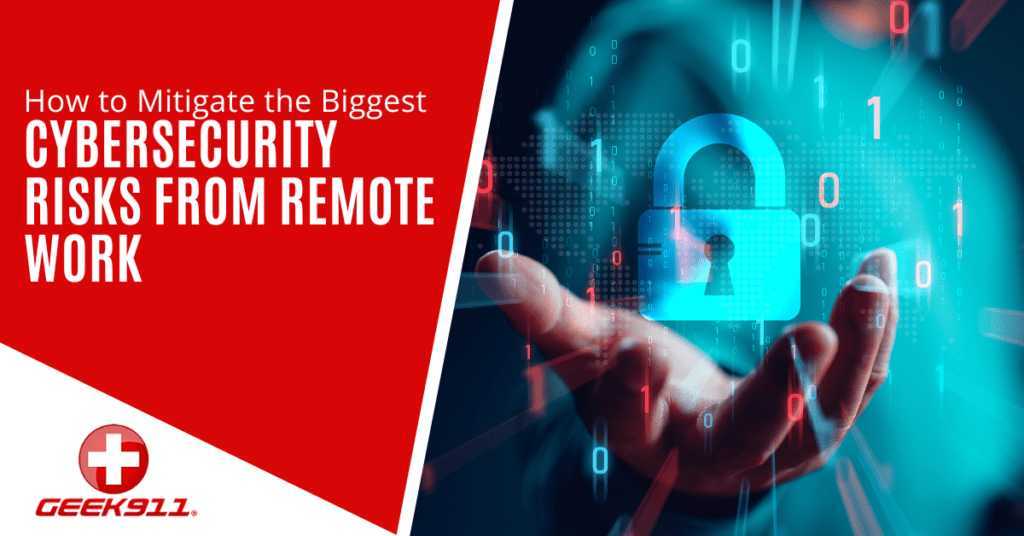How to Mitigate the Biggest Cybersecurity Risks from Remote Work

Thanks to the COVID-19 pandemic, businesses around the world were forced to adopt remote work policies. Remote work is still relevant and evolving, making it imperative to address the cybersecurity risks associated with this new work environment.
While remote work offers numerous benefits, such as increased flexibility and reduced costs, it also exposes organizations to a wide range of cybersecurity threats. In this article, we will explore the biggest cybersecurity risks faced by remote workers and provide actionable strategies to mitigate them effectively.
Phishing Attacks and Social Engineering
Phishing attacks and social engineering remain two of the most prevalent cybersecurity risks for remote workers. Attackers often exploit the vulnerabilities of remote work environments by sending fraudulent emails or messages designed to deceive employees into revealing sensitive information or downloading malicious software.
To mitigate these risks, organizations should:
- Implement robust email security measures: Deploy email filtering solutions that can identify and block phishing emails. Train employees to recognize phishing attempts and report suspicious emails promptly.
- Enable multi-factor authentication (MFA): Implement MFA for all remote access tools, such as VPNs and cloud-based applications. MFA adds an extra layer of security by requiring users to provide additional authentication factors, such as a unique code sent to their mobile devices.
- Conduct regular cybersecurity awareness training: Educate remote workers about the latest phishing techniques and social engineering tactics. Encourage them to verify the authenticity of emails and messages before clicking on any links or sharing sensitive information.
Insecure Remote Access and Weak Passwords
Remote work often involves accessing company resources through virtual private networks (VPNs) or remote desktop protocols (RDPs). If these access points are not properly secured, they can become easy targets for cybercriminals.
To mitigate these risks, organizations should:
- Implement secure remote access solutions: Utilize VPNs and RDPs with strong encryption protocols and regularly update their software to address any known vulnerabilities. Limit access privileges to only those who require it and enforce the use of strong, unique passwords.
- Adopt a zero-trust approach: Implement a zero-trust security model, which assumes that no user or device can be trusted by default. This approach requires continuous authentication and authorization checks, even for trusted users and devices.
- Enforce password best practices: Implement password policies that require employees to use complex passwords and change them regularly. Consider implementing a password manager to facilitate secure password management.
Weak Endpoint Security
Remote workers often use personal devices or unsecured networks to access company resources, increasing the risk of malware infections and data breaches. Weak endpoint security can leave organizations vulnerable to various cyber threats.
To mitigate these risks, organizations should:
- Implement endpoint protection solutions: Deploy robust antivirus and anti-malware software on all remote devices. Ensure that these solutions are regularly updated to detect and mitigate emerging threats effectively.
- Enable device encryption: Require remote workers to encrypt their devices to protect sensitive data in case of theft or loss. Encryption provides an additional layer of security by scrambling data, making it unreadable without the appropriate decryption key.
- Establish network security guidelines: Educate remote workers about the importance of secure Wi-Fi connections and the risks associated with public or unsecured networks. Encourage the use of virtual private networks (VPNs) to encrypt data transmission and protect sensitive information.
Data Leakage and Insider Threats
Remote work introduces new challenges in maintaining data privacy and protecting sensitive information. Employees may inadvertently share confidential data or fall victim to insider threats, leading to significant financial and reputational damage.
To mitigate these risks, organizations should:
- Implement data loss prevention (DLP) solutions: Deploy DLP tools that monitor and prevent the unauthorized transfer of sensitive data. These solutions can identify and block data leakage attempts, whether intentional or accidental.
- Implement access controls and user monitoring: Limit access privileges based on the principle of least privilege (PoLP), ensuring that employees only have access to the data they need to perform their tasks. Implement user activity monitoring to detect any suspicious behavior or unauthorized access attempts.
- Develop a remote work policy: Establish clear guidelines and policies regarding data handling, remote access, and acceptable use of company resources. Regularly communicate and reinforce these policies to remote workers to maintain awareness and compliance.
Tackle Remote Work Challenges Today
As remote work continues to be an integral part of the modern workforce, organizations must prioritize cybersecurity to mitigate the associated risks effectively. Implementing robust security measures, providing comprehensive training, and establishing clear policies, will allow you to protect your sensitive data and infrastructure from cyber threats.
Contact GEEK911 today to learn more about how our cybersecurity services can help protect your organization from remote work-related cyber threats.
